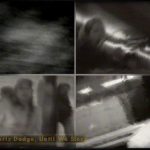Chris Dodge: What Will Remain of These?
Title:
- What Will Remain of These?
Artist(s) and People Involved:
Exhibiting Artist(s):
Symposium:
Artist Statement:
Although we are converging on a ubiquity of computation at a large global scale, we still face unanswered questions of what it means to “be digital”. Through the globalization of both the Internet and computation we are constantly interacting within a community, contributing to the collective digital body. Human interactions are part of patterns that manifest themselves at a larger societal scale. We all tend to lead similar and overlapping lives, leading to a collective group identity that is emergent through these behaviors. Although, at first glance, these group patterns appear to be chaotic, the individual remains locked within their own identity. But if one gets removed enough from the localized context, it becomes clear that we have little control over what emerges as a collective whole. We all lead a life between two poles: the world of motion and the world of stillness. The dialectic between them creates a tension as there are two distinct representative aesthetics at work. The world of motion is one of self-possession, short-term goals, achievement, and drive. The person that is stuck in the world of motion is unable to view themselves in the large group identity, trapped in a merciless temporal now that urges them forward. Likewise, the world of stillness is made out of passivity, narcissism, indecision, uncertainty, and fear. The person in this realm is trapped in an endless self-reflection. The former is a quality of transience, the latter is a quality of permanence. It is between these two extremes that we exist. This work explores these possibilities by visualizing the world of motion and stillness as a metaphor for the struggle between individual and group identities.
An array of surveillance technologies is used to capture live video from people’s everyday life. These images are deconstructed into motion characteristics that describe, over time, how large masses of people are moving through an architectural space. This motion analysis is then used to provide virtual “winds” that blow image particles over the computer screens and data network, forming abstract kinetic visual sculptures that are carved out of the patterns that summarize our motions as a collective societal whole. The more defined and patterned we act as a group, the more smooth and continuous the corresponding particle flow will be. However, should a participant hold very still for a few seconds, this gesture of permanence will be sensed by the surveillance system. The image of the narcissistic viewer is integrated into the virtual particle system for as long as that pose is held frozen. As soon as the viewer moves in any significant manner, his/her image is blown apart by all of the torrential currents of the motions that have come before in time. In a manner, they have achieved a dubious permanence as all of the pixels that form his/her image are retained in the system. Here there is a comforting Newtonian conservation of mass and energy, where traces of our existence persist eternally in the digital environment.
Technical Information:
An array of surveillance technologies is used to capture live video from people’s everyday life. These images are deconstructed into motion characteristics that describe, over time, how large masses of people are moving through an architectural space.







